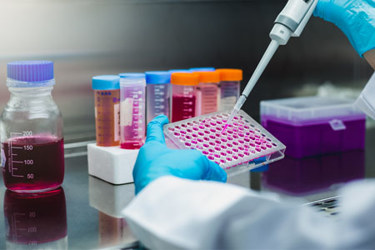What You Should Know About USP's Bioassay Updates
A conversation with Xiaolei Zhuang, Ph.D., United States Pharmacopeia

Revisions to the United States Pharmacopeia’s (USP) General Chapters <1030> Biological Assay Chapters – Overview and Glossary and USP <1033> Biological Assay Validation are winding their way through the comment and update process, and the final versions of <1030> and <1033> are on target to become official in 2026.
The other two general chapters included in this effort, USP <1032> Design and Development of Biological Assays and USP <1034> Analysis of Biological Assays, will be updated in the 2025-2030 cycle.
According to the drafts proposed for comments by the General Chapter Statistics Expert Committee (GC-STAT EC) in the Pharmacopeial Forum (PF), updates include:
- <1030> Biological Assay Chapters - Overview and Glossary: GC-STAT EC has proposed revising the title of this chapter to “An Introduction to the Biological Assay Chapters—Overview and Glossary” to add further clarity. They have also proposed including new sections on bioassay characteristics, categories, and levels of variability in the bioassay life cycle in addition to a glossary and specific sections to support the other bioassay chapters.
- <1032> Design and Development of Biological Assays: The PF proposal has been revised to place greater emphasis on the bioassay life cycle approach. The updated chapter emphasizes integrating study design with data analysis and offers clearer direction on structuring studies to align with statistical models.
- <1033> Biological Assay Validation: The proposed revision is designed to be practical, aligned with current industry expectations, and better integrated with the broader USP framework. In addition, the chapter has been revised to harmonize with related USP chapters <1010> and <1210>.
- <1034> Analysis of Biological Assays: This updated chapter has been reorganized to make the primary material more accessible and move more advanced topics to a separate section; however, statistical methods in this revision are not substantially different from the previous version
In the meantime, we want to start unpacking these chapters, as they provide helpful guidance on bioassay development and implementation.
Xiaolei Zhuang, Ph.D., a principal scientist at USP, agreed to answer questions about the updates and current thinking on bioassay development and validation in general. Her answers have been edited for brevity and clarity.
In the context of <1032>, how early should fitness for use considerations dictate the assay format and the design parameters?
Zhuang: You want to have fitness for use in mind from the beginning of your assay design. You need to be clear about the use of your assay; for example, is it for lot release of drug substances or products, stability assessment, or supporting process development? In each case, the requirements for accuracy, precision, repeatability, and linearity may be different. Your assay might be designed differently based on needs and expectations.
As recommended in <1032>, you may want to design your assay to fit multiple purposes, so you don't need to develop separate assays for each individual need and save time and labor. Therefore, early consideration of fitness for use helps ensure your assay is appropriately designed to meet its intended analytical goals.
When is it appropriate to lock in your procedure, and what minimum evidence should justify that decision?
Zhuang: Typically, it’s appropriate to lock in a bioassay procedure once the assay has been fully developed and shown to be fit for its intended use, however, it can be different on a case-by-case basis. According to <1032>, locking your assay procedure typically occurs at the end of the development phase and may be confirmed through a qualification trial or during validation.
As stated in <1032>: “An endpoint of assay development is the completed development of the assay procedure, a protocol for the performance of the bioassay.” Thus, locking in the procedure is justified when the assay has been shown to meet predefined performance characteristics and is ready for routine use, including for regulatory submissions. Generally, the minimum requirement to justify locking in the procedure might include, but is not limited to, confirmed assay robustness under defined conditions, established system and sample suitability criteria, demonstrated assay precision and accuracy, and a finalized written procedure.
What do you see as the most common missteps in validating a biological assay and how do the general chapters try to prevent them?
Zhuang: Among the issues I see at qualification and validation is a rush to lock procedures before the assay is fully developed and evaluated. Inadequate development will lead to poor assay performance (e.g., a lack of precision and accuracy) and subsequent issues during qualification and validation.
Critical reagents are another important factor to which may sometimes be neglected during validation. The critical reagents or cell lines need to be properly characterized or qualified prior to validation. Additionally, you also want to reserve sufficient stock of your critical reagents to avoid shortages. Those factors are essential for qualification and validation activities.
Ultimately, successful qualification and validation require thorough planning before execution.
How does USP recommend handling reference standard assignment, especially when in-house standards and the public standards disagree?
Zhuang: Bioassays are very different from physical and chemical assays. It’s not producing an absolute measurement, but a relative measurement reported as relative potency.
Without a reference standard, you don't have an assay. That's why the reference standard is very important for bioassays. You have two primary sources for reference standards:
- Establishing your standard in-house: This is common when developing new products and there’s no suitable commercial material to be used as a reference standard.
- Sourcing your standard from an institution: Public standards like the WHO international standard or a standard from a pharmacopeia such as USP.
The standard is a critical reagent used to assign relative potency. It should be representative of the test samples and stable overtime. Both are good if they have been evaluated carefully; for example, it is important to establish similarity between the reference standard and your sample or product.
For standards developed in-house, one advantage is that you have control because they’re your own materials. On the other hand, using your own materials can be a disadvantage because they must be fully characterized. You must make sure your standard functions as meant to, and that it meets the requirements from an audit perspective. You don’t need to worry about those issues with public standards. Public standard development includes collaborative efforts from global labs, which adds more confidence to the value assignment.
In cases of discrepancy between in-house and USP Reference Standards, it should be evaluated on a case-by-case basis. When compendial methods are used, the public standards, such as USP Reference Standards, take precedence in compendial testing and regulatory submissions. As stated in USP General Notices Section 5.80, “where USP or NF tests or assays call for the use of a USP Reference Standard, only those results obtained using the specified USP Reference Standard are conclusive.” However, for non-compendial or in-house methods, it’s recommended to conduct thorough comparability studies between the in-house standard and the public standard to determine the root cause of the discrepancy.
General Chapter <1034> discusses ongoing monitoring and drift detection. What are your recommended statistical tools or thresholds for triggering requalification? At what point do you say, ‘OK, we need to go back and requalify this’?
Zhuang: Ongoing monitoring of bioassays is considered essential to maintain performance and detect drift or systematic changes over time. <1034> recommends a few tools, such as system suitability or sample suitability tracking and statistical control charts. Parameters such as slope, EC50, and signal/noise should be tracked using control charts to detect trends or shifts. One best practice is to include a well-characterized sample as assay control in every assay run and monitor the measured relative potency. A consistent increase or decrease with the trending parameters may indicate drift or system change, which should be investigated further for the root cause.
The threshold or predefined criteria to trigger requalification largely depends on the assay and your product. You may want to work with a statistician to set up a proper threshold.
What practical strategies help distinguish meaningful biological signal shifts from natural assay variability?
Zhuang: First, take a close look at your trending chart and determine if the change you're seeing falls within the normal variability range. If the change appears significant, you should consider whether it’s aligned with any known changes in materials, processes, or reagents.
Beyond that, it’s also a good idea to compare your bioassay results with data from other orthogonal methods, especially the ones that aren’t based on biological activity. This can help you figure out whether the shift is something specific to your assay or something with the product itself.
The bioassay chapters are not enforceable by regulators. How do we align the technical rigor of these chapters given their non-mandatory designation?
Zhuang: The USP chapters numbered above 1000 are informational chapters and are intended to provide technical guidance, reflect industry’s best practices, and facilitate knowledge sharing. The bioassay chapters mentioned above fall within this category. While these standards are not considered applicable according to USP’s General Notices, they are valuable from both the scientific and regulatory perspective. The chapters were developed by USP’s General Chapter Statistics Expert Committee with input from other expert volunteer bodies from regulatory agencies, academia, and industry. They are well-aligned with FDA guidelines and ICH guidance.
Practically speaking, these chapters provide a valuable framework for robust bioassay development and regulatory alignment. Applying the concepts and approaches outlined in these chapters will help to identify and address potential gaps early in the development process and reduce risks at later stages.
About The Expert:
 Xiaolei Zhuang, Ph.D., is a principal scientist at USP where she leads the development of reference standards for therapeutic proteins, monoclonal antibodies, oligonucleotides and other biologic products. She brings extensive expertise in analytical development, with a strong emphasis on bioassays. Prior to joining USP, she worked in the biopharmaceutical industry, supporting the development of biological therapeutics through analytical, preclinical, and clinical studies, with a focus on CMC components.
Xiaolei Zhuang, Ph.D., is a principal scientist at USP where she leads the development of reference standards for therapeutic proteins, monoclonal antibodies, oligonucleotides and other biologic products. She brings extensive expertise in analytical development, with a strong emphasis on bioassays. Prior to joining USP, she worked in the biopharmaceutical industry, supporting the development of biological therapeutics through analytical, preclinical, and clinical studies, with a focus on CMC components.
